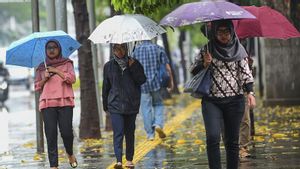JAKARTA - LAPAN Center for Atmospheric Science and Technology (PSTA) researcher Eddy Hermawan said the high rainfall in Indonesia is predominantly influenced by monsoon winds and the high index of the IOD (Indian Ocean Dipole).
"The monsoon is because of the movement of the wind that carries water vapor from either the Asian monsoon or the Australian monsoon," he said as quoted by Antara, Wednesday, September 1.
Eddy explained that the high rainfall was also caused by the IOD which caused a deviation from the interaction of climate by the sea and the atmosphere around the eastern Indian Ocean, resulting in a high pressure that made the air blow towards the west.
The IOD has two poles, namely the Dipole Mute Positive which is associated with rising sea surface temperatures in the western Indian region of Indonesia and the Dipole Mute Negative which is associated with the wet season (rainy season).
These two types of IOD dipoles will affect the high pressure in an area and the occurrence of convective cloud formation. He said the rain would fall in the center of low pressure and may move to another lower pressure, forming a complex phenomenon. He gave an example, from August to September, Java should experience the peak of the dry season. However, to this day the weather is still cloudy. He said the condition was caused because the temperature around the sea surface was still warm.
"I suspect the IOD although it does not drop to the negative phase, it must be remembered that the sea surface temperature around the Indonesian region is still warm. So, the Sea Surface Temperature (SST) in the area around Indonesia, especially in southern and western Sumatra, the SST is still relatively high," he said explaining the current weather conditions in Indonesia.
Eddy estimates that this condition will occur until October, due to the Asian Monsoon wind which brings large amounts of water vapor from the Pacific Ocean coupled with the strength of pressure from the west.
“What is clear is that there is a vortex around the western part of southern Indonesia, such as near Christmast Island, but it doesn't end there. He was pushed towards Sulawesi. So on August 28 yesterday, Sulawesi was hit hard by this phenomenon," he said.
The English, Chinese, Japanese, Arabic, and French versions are automatically generated by the AI. So there may still be inaccuracies in translating, please always see Indonesian as our main language. (system supported by DigitalSiber.id)













